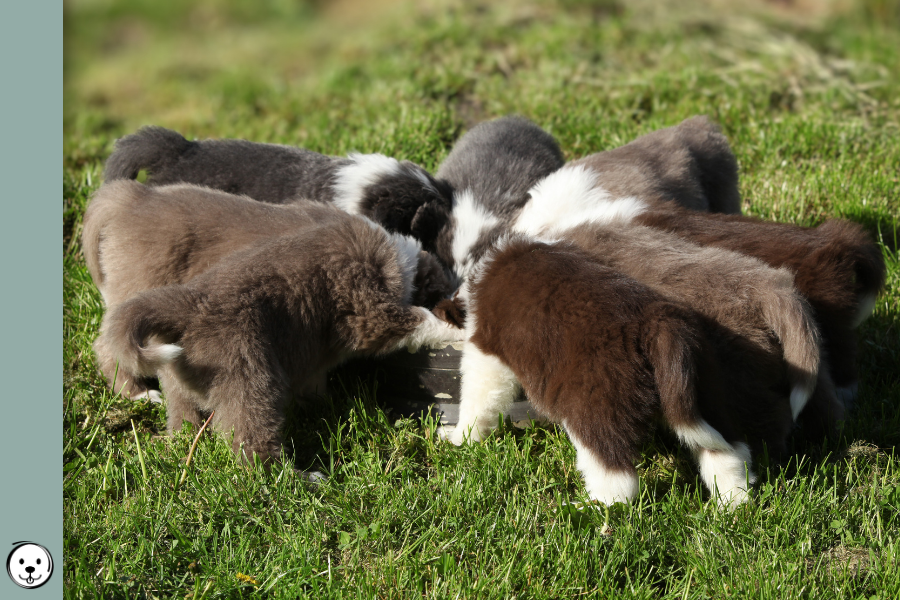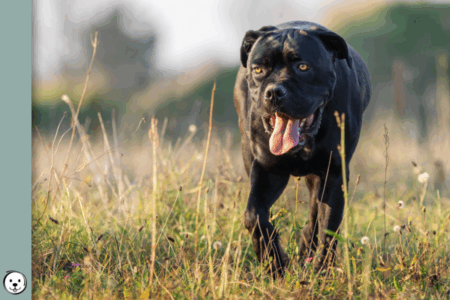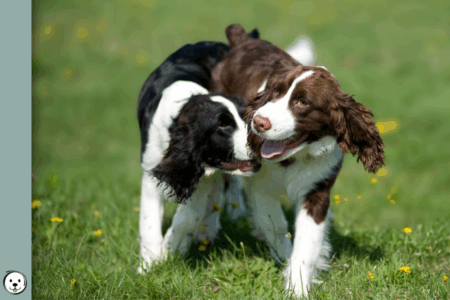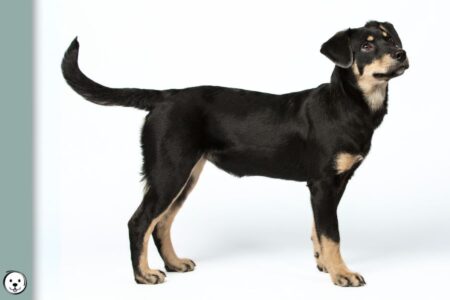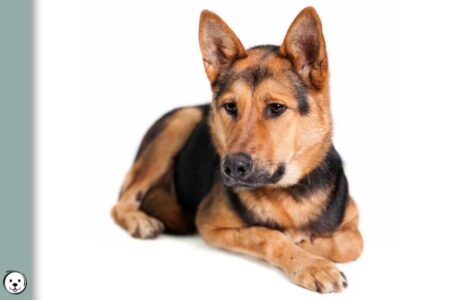Learn about the base colors of eumelanin.
Eumelanin is the dark type of pigment we see in canine coat colors. The most common color is the “wild type” black. However, eumelanin can be modified to other base colors, namely brown, blue, and lilac.
We call them “base colors“, because they determine the darkest possible shade of eumelanin a dog can produce. Other traits can only affect how well these base colors will be visible in the phenotype. But secondary traits (e.g. merle) can not change the theoretically possible darkest color of eumelanin.
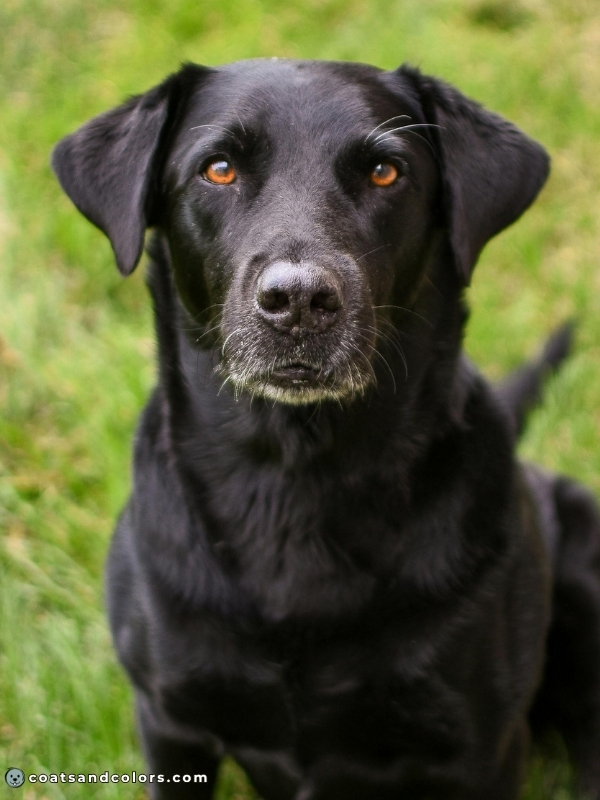
B/- D/-

B/- d/d

b/b D/-
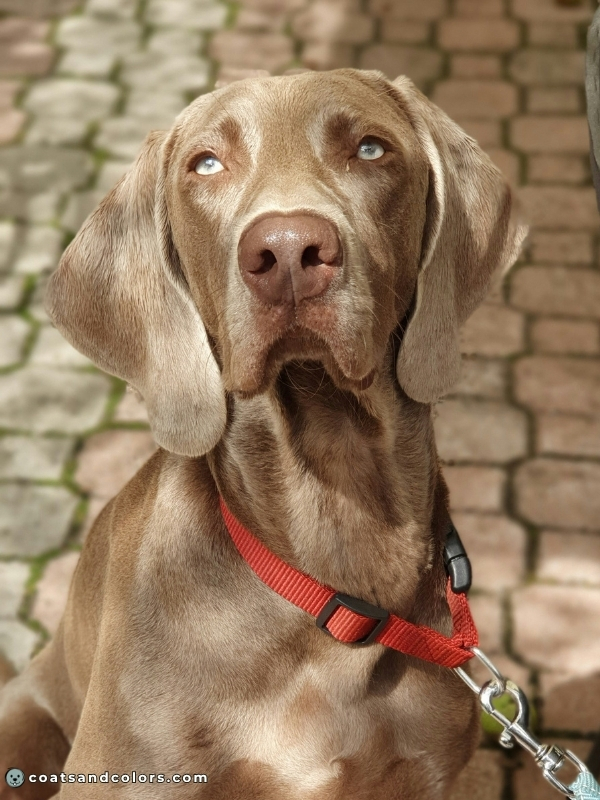
b/b d/d
Table of Contents
Eumelanin vs. Phaeomelanin
Only two pigment types determine coat color in dogs, eumelanin and phaeomelanin.
Phaeomelanin is a yellow-red pigment. Its color intensity varies depending on pigment density. This means dogs can have any colors on a continuous gradient from very pale cream to very deep red.

Eumelanin is a black pigment. However, black can be modified to either blue, brown, or lilac. Black can also be modified to cocoa. But this only happens in off-standard French Bulldogs, so we’ll ignore it til later.

The distribution of both pigment types (black and yellow) in the coat is called the base pattern.
Some dogs are solid dark with only eumelanin in their coat.
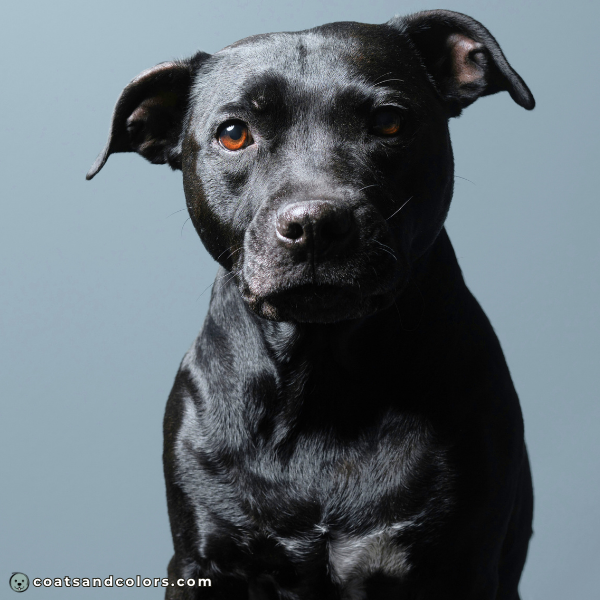
Some dogs are solid yellow with only phaeomelanin in their coat.
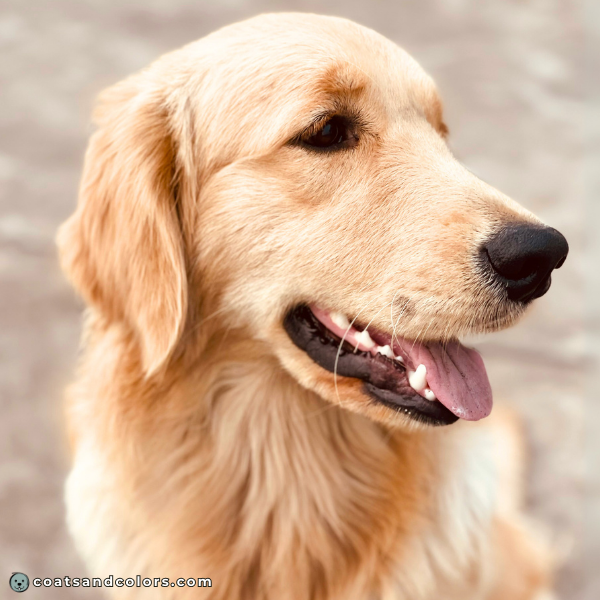
But many dogs have a patterned coat with both pigment types.
Think of black-and-tan with a black coat (eumelanin) and distinct tan markings (phaeomelanin). Or sable brindle with a yellow base (phaeomelanin) and black stripes (eumelanin) on top.
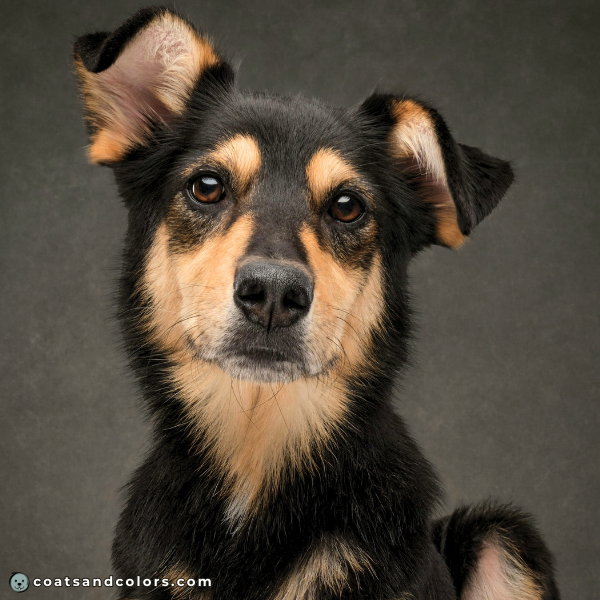

You will find eumelanin in other places than just the coat:
The eyes, whiskers, paw pads, nails, nose, eye rims, and lips will always express only eumelanin!
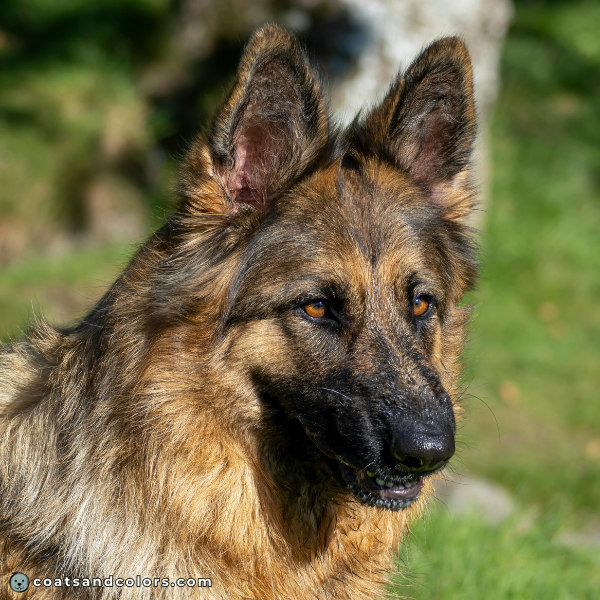
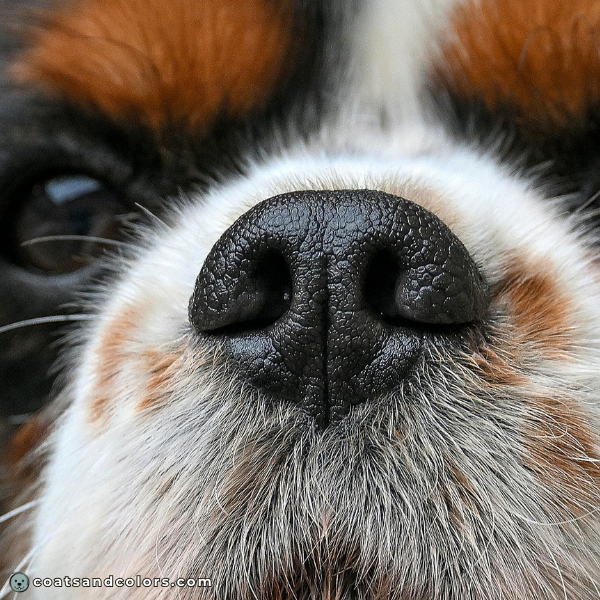
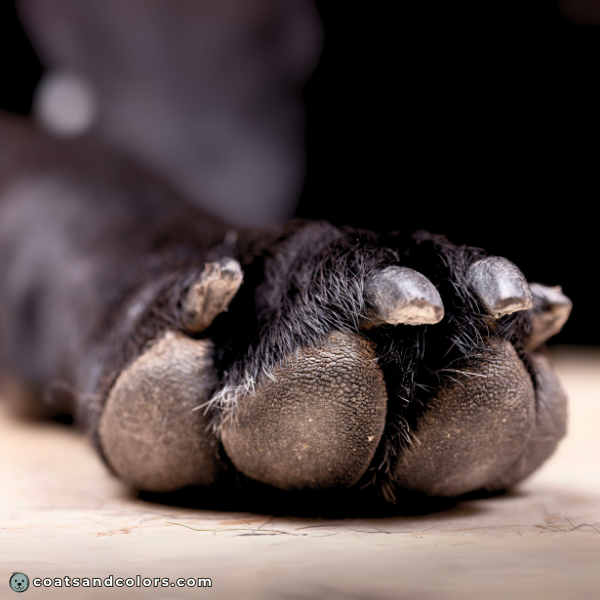
Some dogs are solid cream, yellow, or red (mainly from being either recessive red or clear sable). These dogs have no eumelanin in their coat. The nose pigment in recessive reds can be weak and may look brownish in black-based patterns and pink in brown-based patterns, so you have to look closely.
Very extended white markings may also hide eumelanin due to a general lack of pigment in a solid white coat. But you can still assess nose colors to see what color of eumelanin a white dog has.
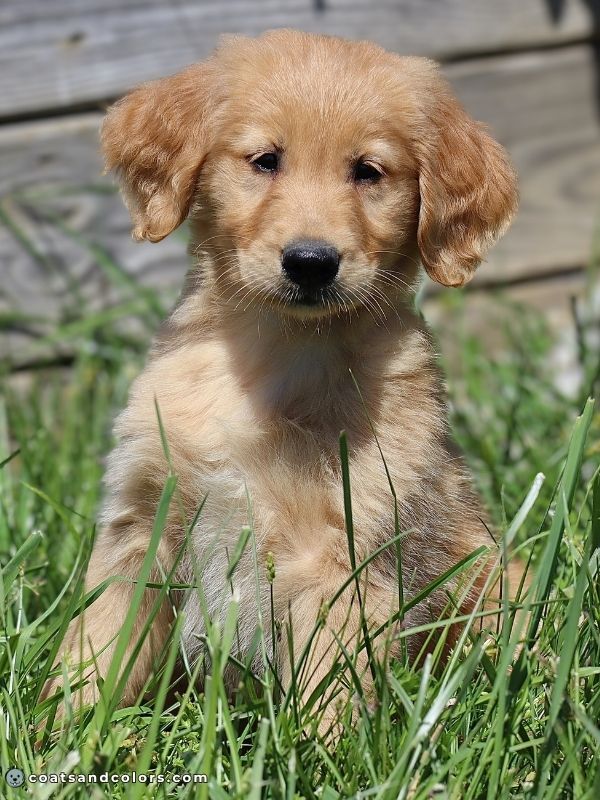
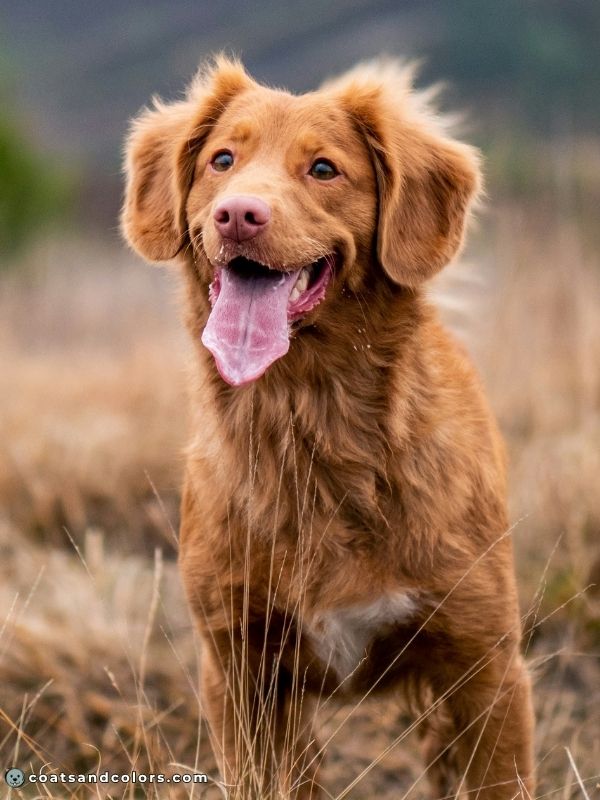

Eumelanin Base Colors
The base color determines the darkest possible shade of eumelanin a dog can produce.
The default color of eumelanin is black.
The B locus modifies black to brown if the dog is homozygous recessive b/b.
The D locus can then dilute eumelanin if the dog is also homozygous recessive d/d.
This gives us four possible eumelanin base colors:
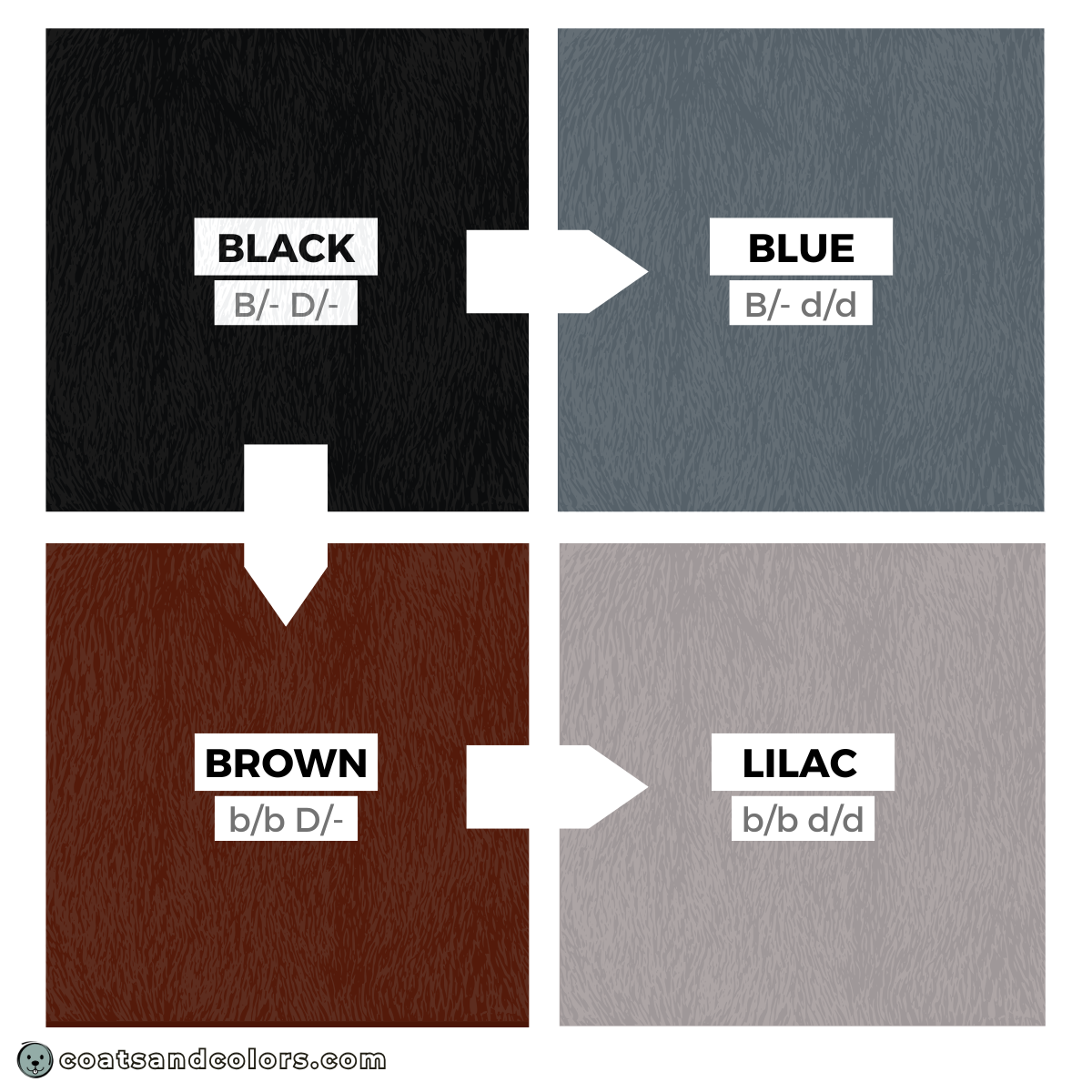
Each dog can have only one distinct base color of eumelanin.
Any base pattern is either black-based or brown-based or blue-based, or lilac-based.
In color genetics, it is a misnomer to describe red sable dogs as “brown with black overlay” or tan points as “black & brown” or blue merle as “black & blue”! Each dog can only have one of these colors at a time.
The eumelanin base color will always affect all the eumelanin on a dog.
For example, a dog with a black-based pattern will also have a black nose, black lips, black paw pads, black eye rims, etc. And black-based patterns produce, on average, dark eye colors.
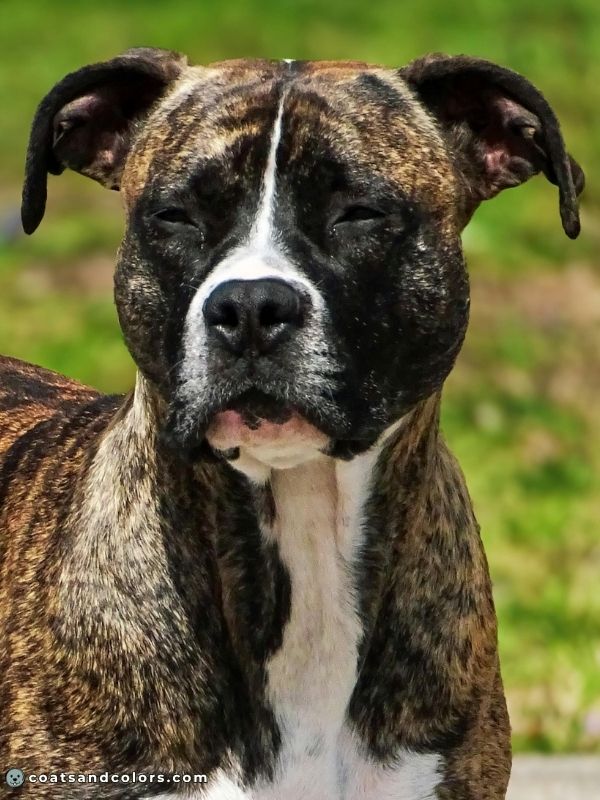
Black
Dogs with one or two dominant alleles (B/B or B/b) at the B locus will produce black eumelanin.
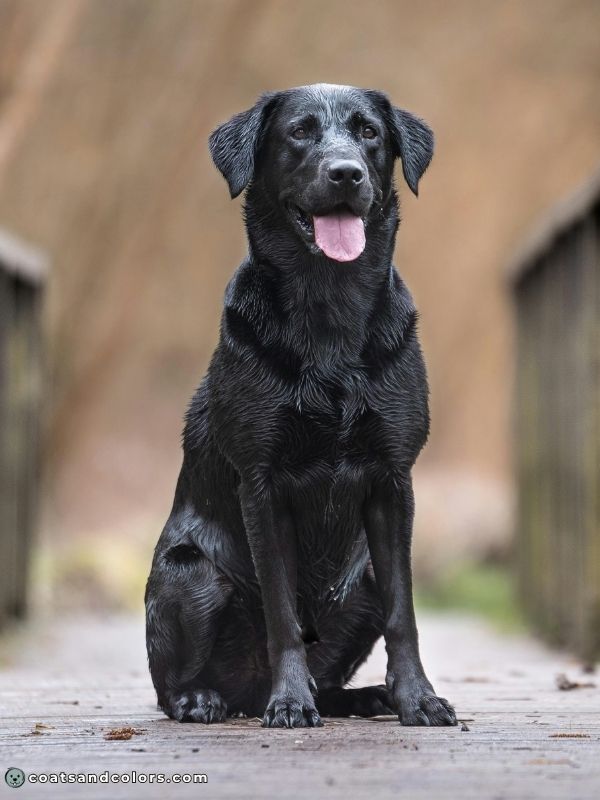
Dogs can be solid black or have a black-based pattern with both black and yellow pigment (and maybe some white). Black is the most common base color in dogs since it represents the wild type.
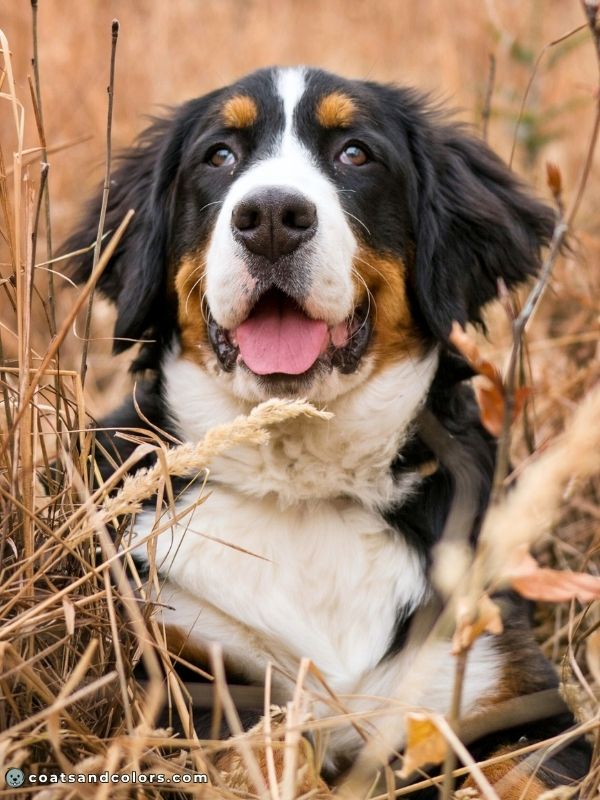
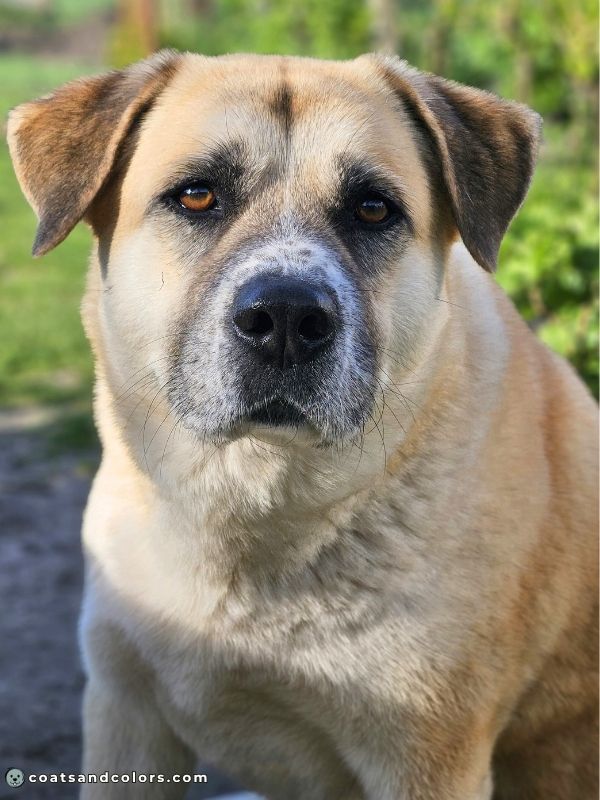
Black pigment can be affected by some other traits:
Progressive graying will cause all the black in the pattern to fade to gray or silver over time. Some breeds call this “blue” because it mimics diluted pigment. But faded black dogs have a black nose.
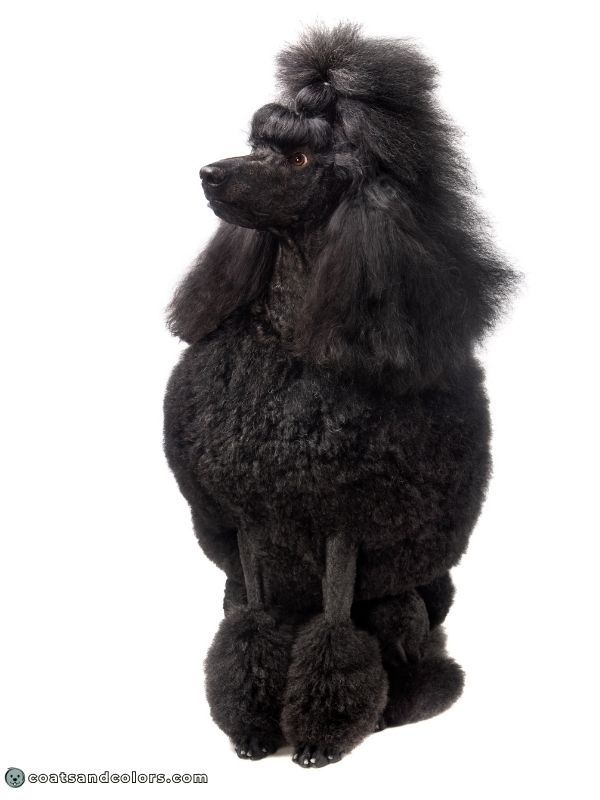
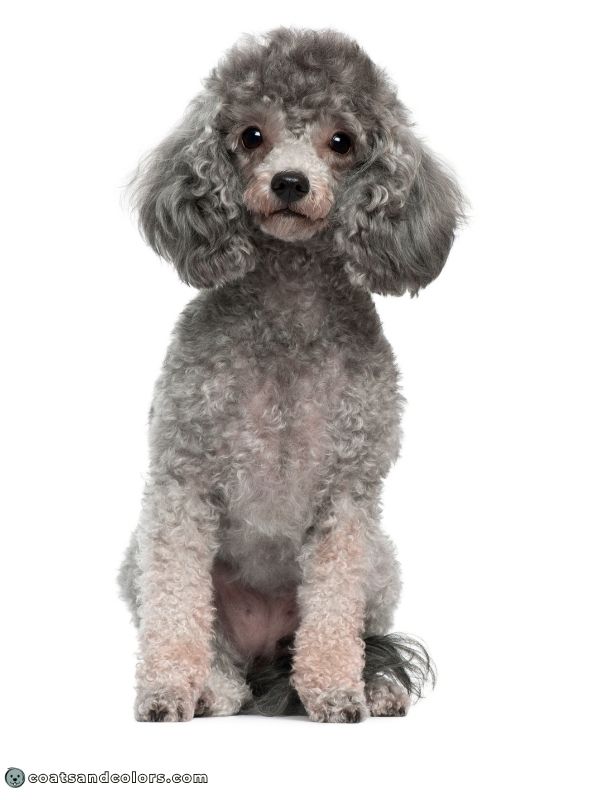
Merle will dilute some of the black to a lighter color. It can also cause “dilute spots” of different colors, even some brownish patches. Black merle is often called “blue merle” because it looks so gray.
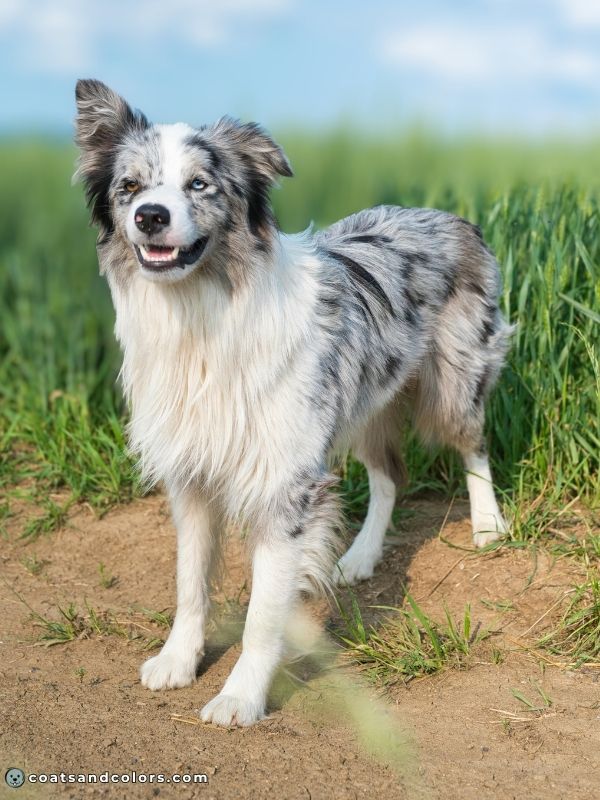
Some ticking or roan can add mottles back into white markings. Very dense mottling or roan patterns are sometimes called “blue tick” or “blue roan“, but these dogs are still black and not diluted.
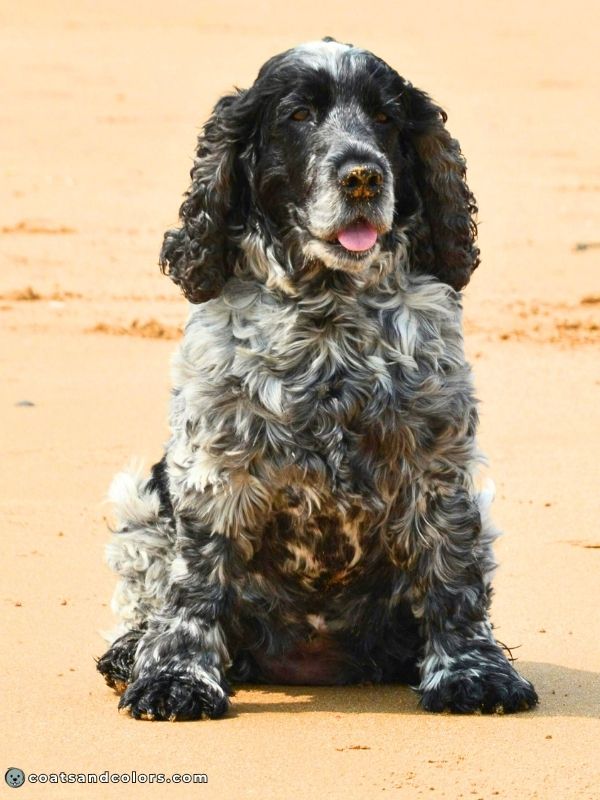
A ghost pattern can make solid black areas look brownish (some breeds call it “bad black“).
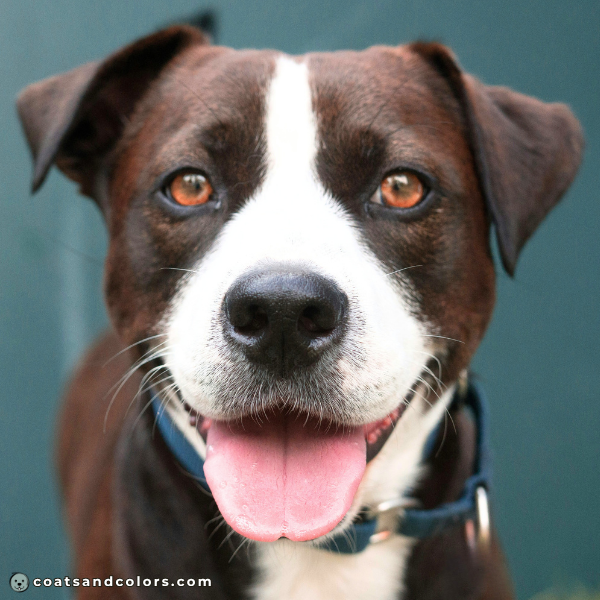
Some old black hairs can also look very reddish right before shedding season. This kind of “rusting” happens in many long-haired black dogs and often causes some pale fluff behind their ears. This can be especially pronounced in black puppies who often get brownish before they shed out their puppy fluff.
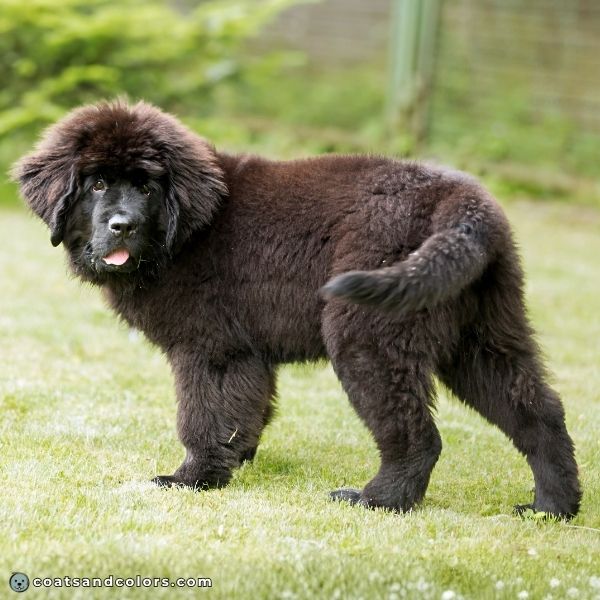
Domino reduces eumelanin, it can cause light undercoat and pale hair roots. The coat in many black-based domino patterns looks more grayish than black. KB domino is even called “blue” in some breeds.
The domino traits (Northern domino and Grizzle domino) are allleles of the E locus. They are part of the “pigment type switch” that determines a dog’s base pattern of pigment distribution.
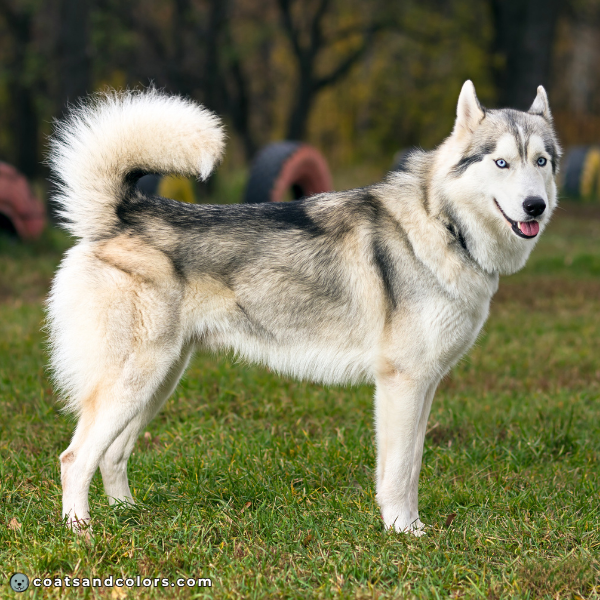
Brown
Dogs with two recessive alleles (b/b) at the B locus will produce brown eumelanin. Dogs with a brown-based pattern have a brown nose, lips, whiskers, etc. All the eumelanin in their pattern will be brown.
Brown eumelanin pigment is most commonly called chocolate or liver in dogs. It can affect any pattern, e.g. solid chocolate, brown sable, chocolate brindle, brown & tan, etc.
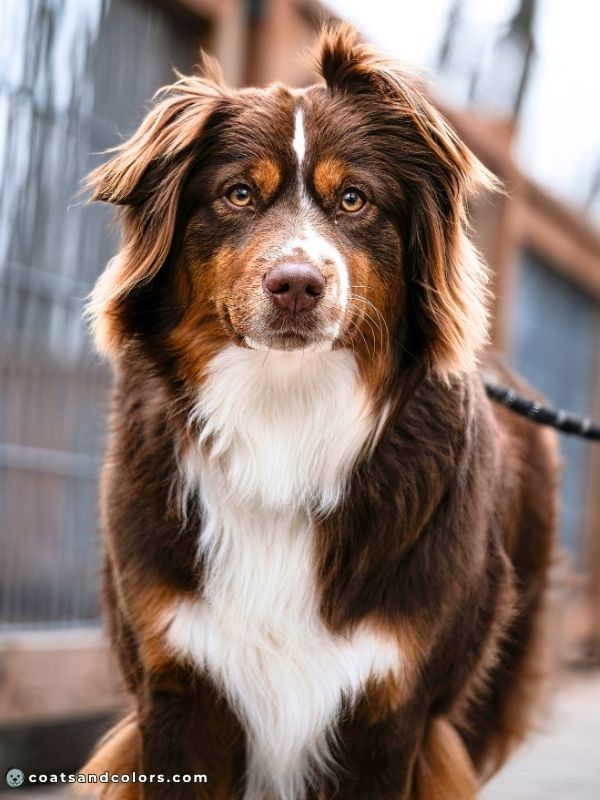
You may have read the term “brown” to describe phaeomelanin and the term “red” to describe eumelanin. In color genetics, we don’t do that. Only eumelanin can be brown. Only phaeomelanin can be red!
A red dog can have any nose color. A brown dog always has a brown nose.
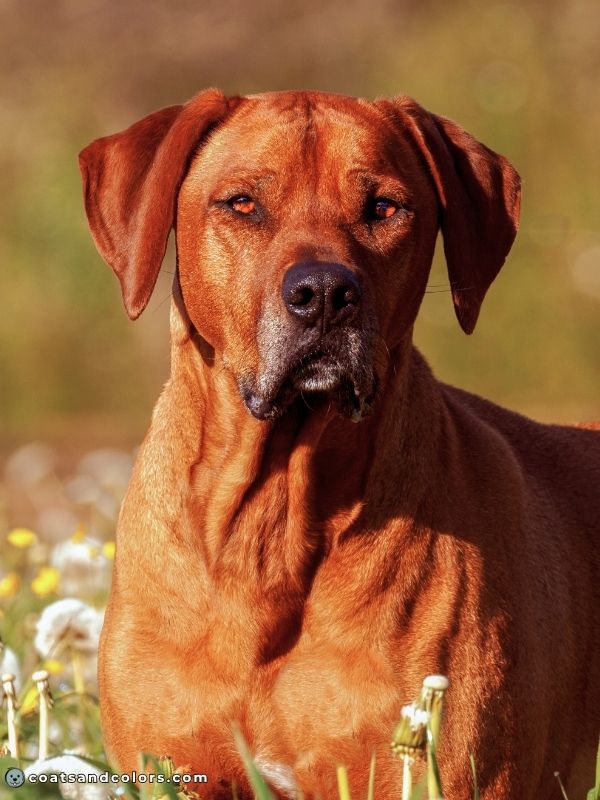
Most Rhodesian Ridgebacks have a black-based sable pattern with a red coat and a black nose.
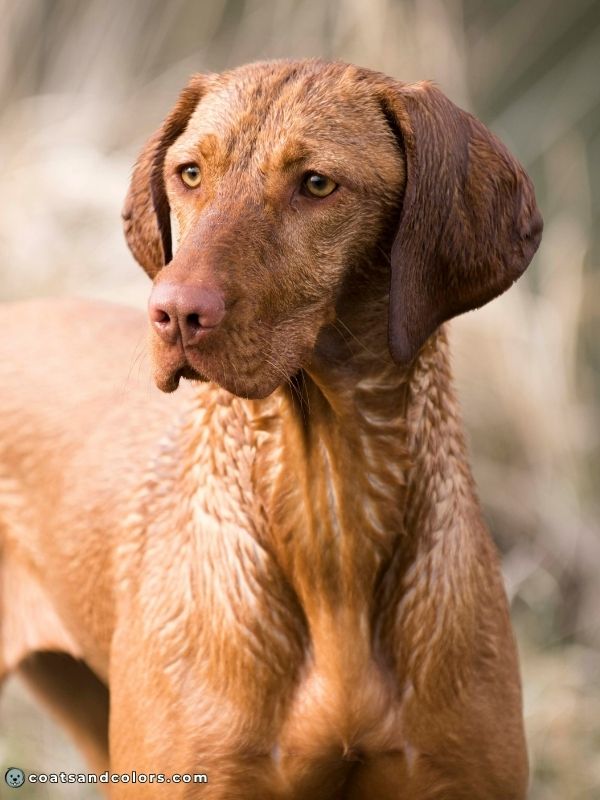
All Vizslas have a brown-based recessive red pattern. They have a solid red coat but a brown nose.
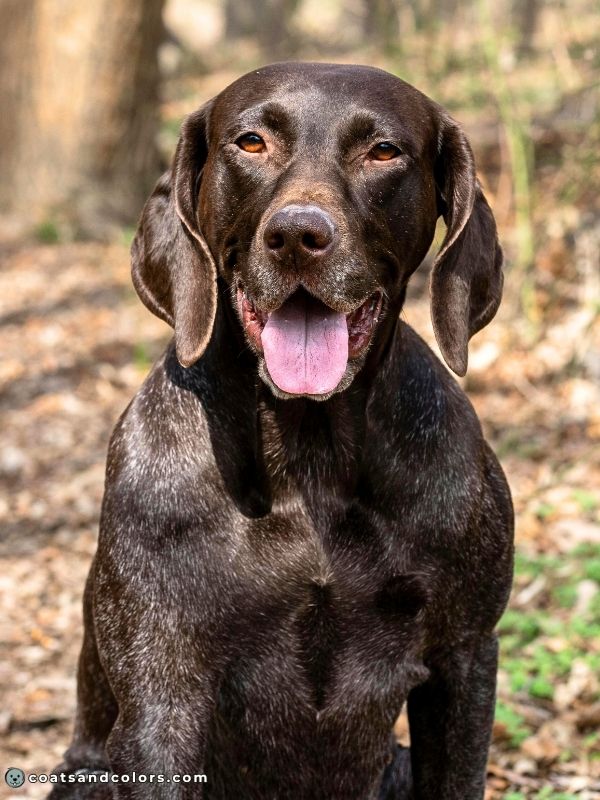
This German Pointer has a solid brown pattern (with some white markings and roaning).
There is a range of brown colors with some dogs expressing a darker brown than others. The more eumelanin, the darker the color. However, it is not known what causes this variation.
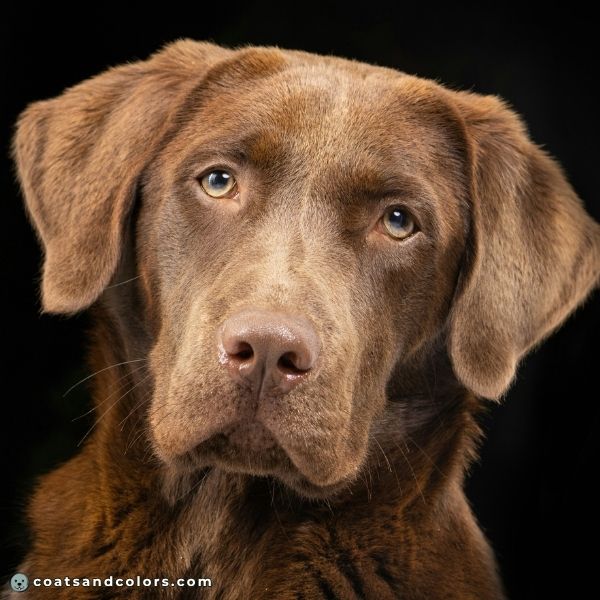
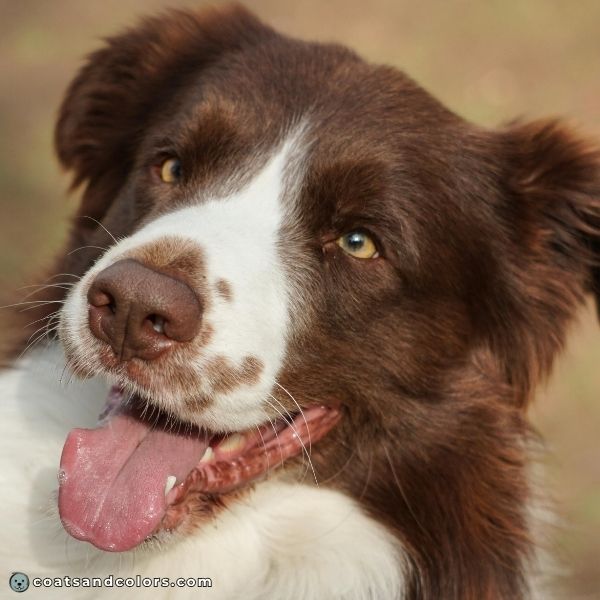
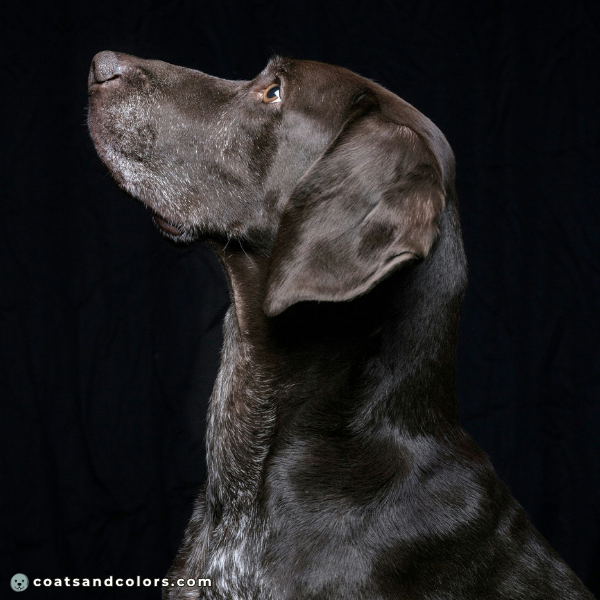
A ghost sable pattern can make yellow areas appear on a solid brown dog.
And brown dogs are also a little more prone to sun-bleaching. This starts from the hair tips in exposed areas and degrades pigment from brown to lighter shades of yellow. Many brown & white working Border Collies or long-haired gun dogs can look very orange by the end of the season.
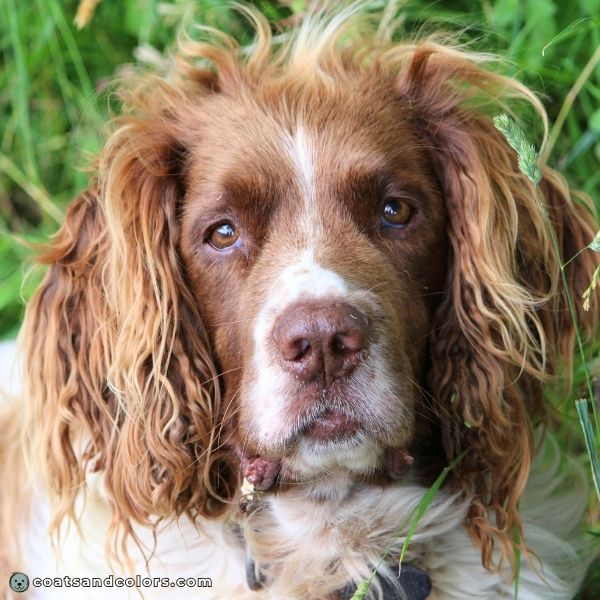
Progressive graying will cause all the brown in the pattern to fade to a sandy taupe over time. There are many breed terms like beige, sandy, cafe au lait, … for faded brown.
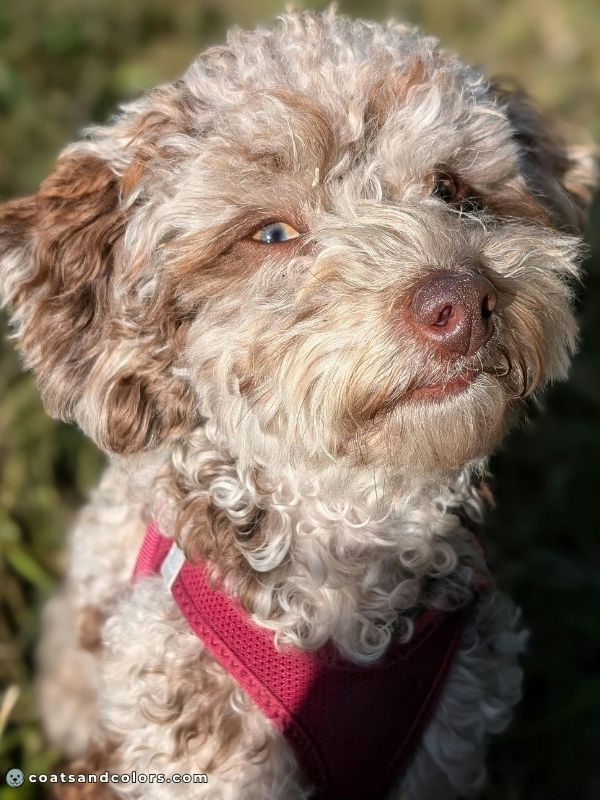
Brown merle will dilute some of the brown to a lighter color. The merled areas on a brown dog can look very pale grayish brown. Many breeds call merle on a brown base color “red merle“.
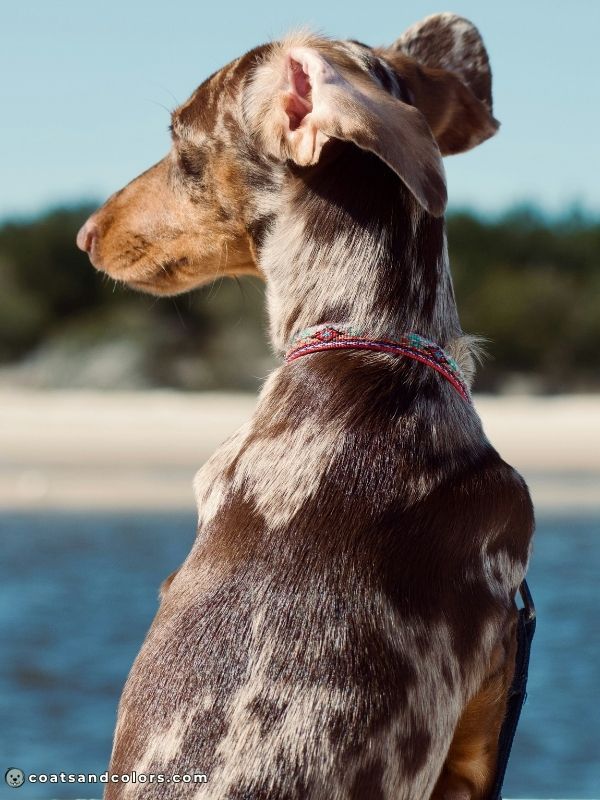
Blue
Dogs with one or two dominant alleles (B/B or B/b) at the B locus and color dilution (d/d) at the D locus will produce diluted black eumelanin. This is what we call blue.
Some breeds call it ash, slate, gray, etc, Any pattern can be blue-based, some of the most common variations are solid blue, blue-based sable, blue & tan, or blue brindle. Diluted black seems to be less common in agouti and saddle breeds, but some Beagles have blue saddles.

There is a range of blue colors with some dogs expressing a darker gray than others. The more eumelanin, the darker the color. Sometimes, very dark blue noses can look almost black.
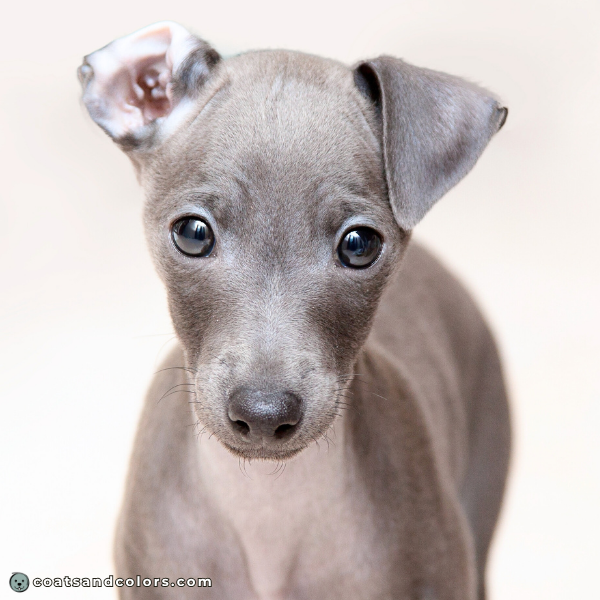
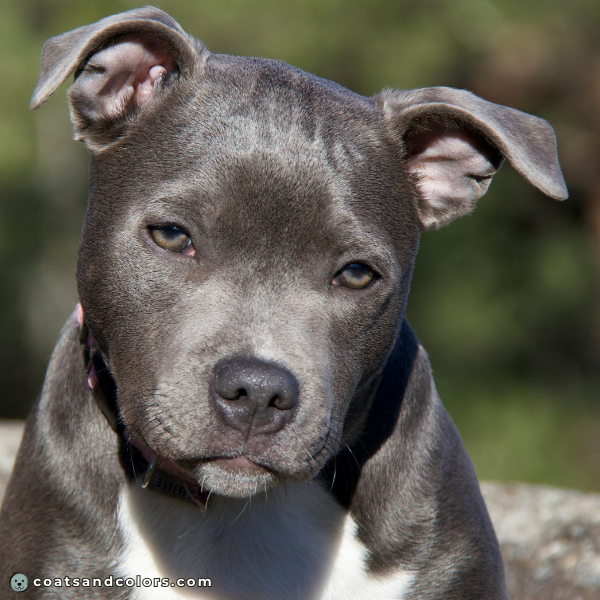
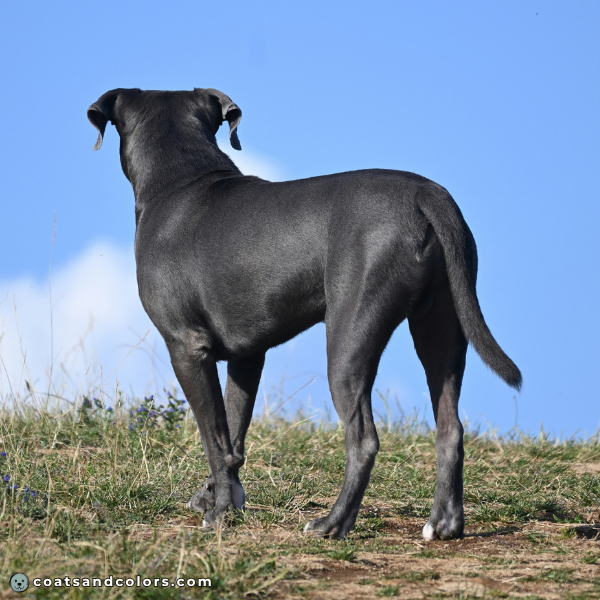
Progressive graying can cause the blue to fade to a very light silver over time. But this combination is rare because breeds with graying don’t really need diluted pigment since their dogs look gray anyway.
In Bearded Collies, they distinguish between “born black” and “born blue” for this reason.
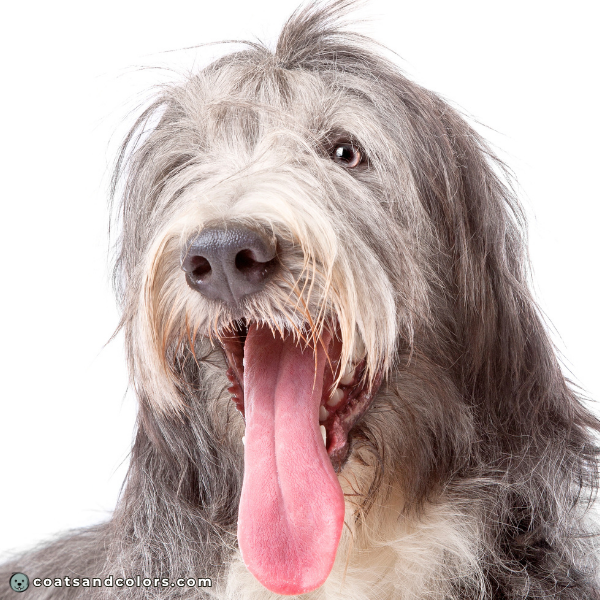
Blue-based merle will dilute some of the blue to an even lighter color.
Some breeds call this “slate merle” or “gray merle” or other to distinguish diluted black merle from normal black merle because the latter is typically already called “blue merle“.
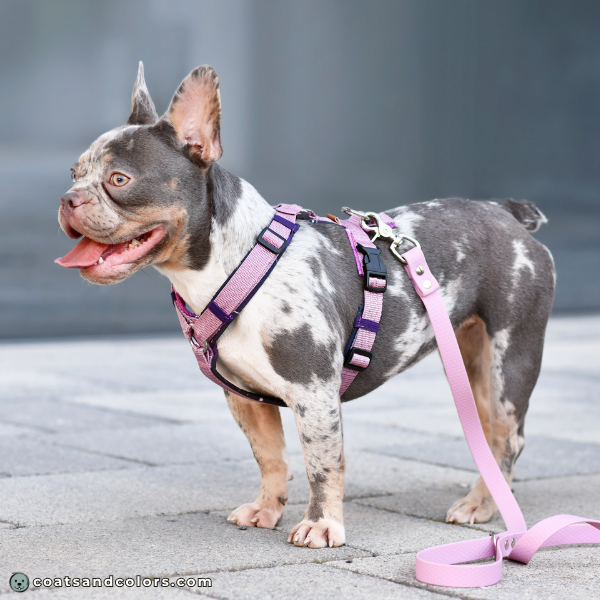
Blue seal (ghost sable) can cause pale yellow to reddish areas of coat on what should be a solid blue dog.

(blue-based ghost sable)
Lilac
Dogs with two recessive alleles (b/b) at the B locus and color dilution (d/d) at the D locus will produce diluted brown eumelanin. This is what we call lilac. Some breeds call it isabella, fawn, gray, …
Any pattern can be lilac-based, e.g. solid, lilac brindle, lilac fawn, or lilac & tan.
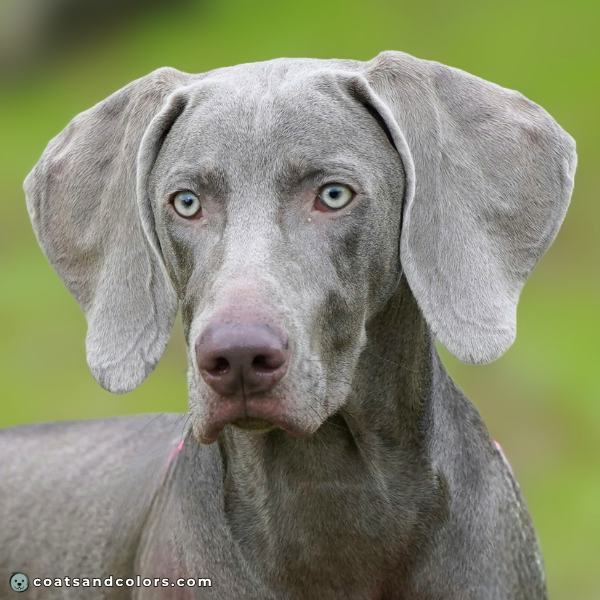
Lilac covers the whole range from very pale beige to “almost brown” taupe colors. Especially the nose pigment can get so dark that it can be hard to guess if a dog is lilac or just pale brown just from its nose.
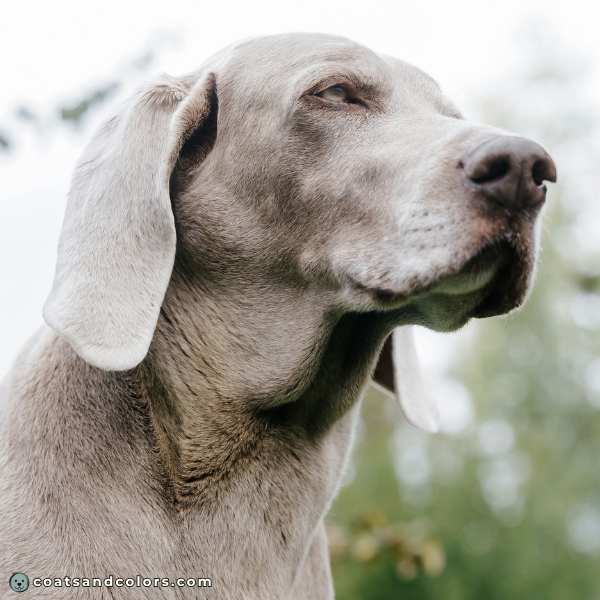

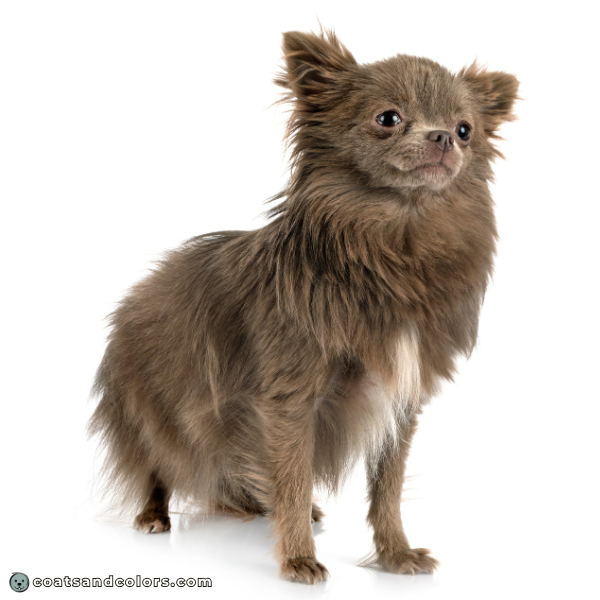
Lilac can be quite pale in some dogs or almost brown in others. It can be hard to see if a lilac dog is maybe lilac seal with reddish undertones. Or if a bearded lilac dog has some graying going on.
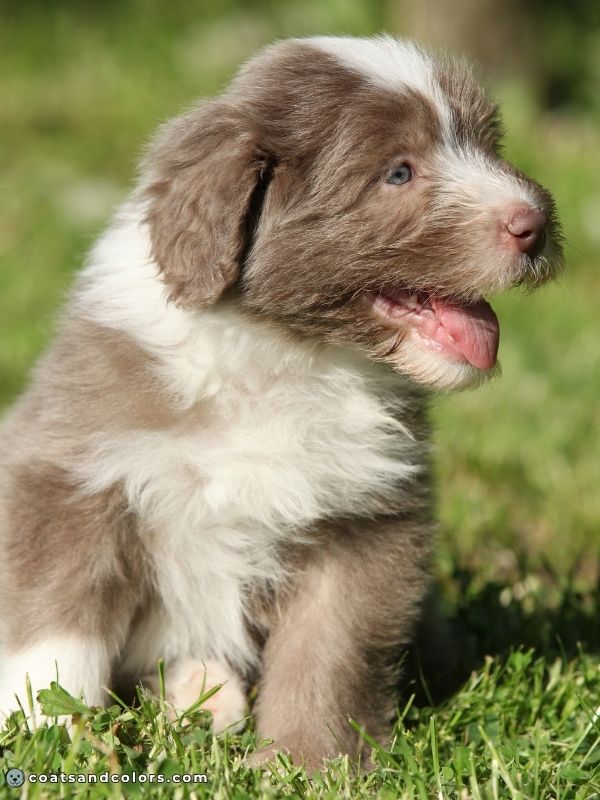
Lilac Merle will dilute some of the lilac to an even lighter color.
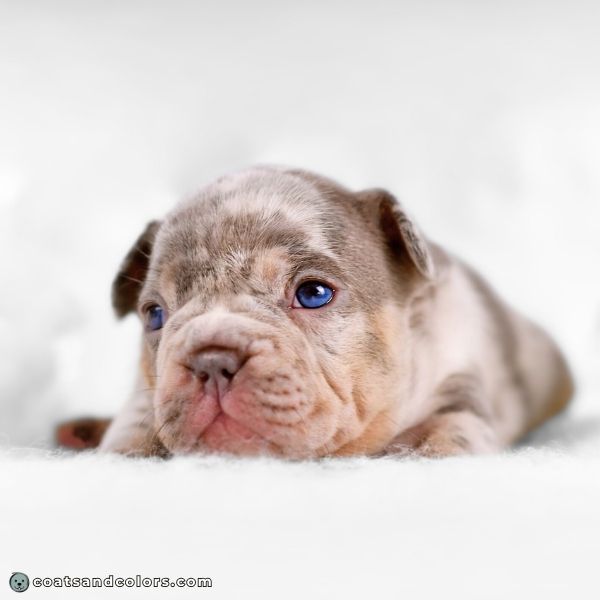
Cocoa
Cocoa is a rare trait that causes dark grayish brown eumelanin. This is also a recessive trait, dogs need two copies to express cocoa (co/co). The difference to normal brown (b/b) can be subtle.
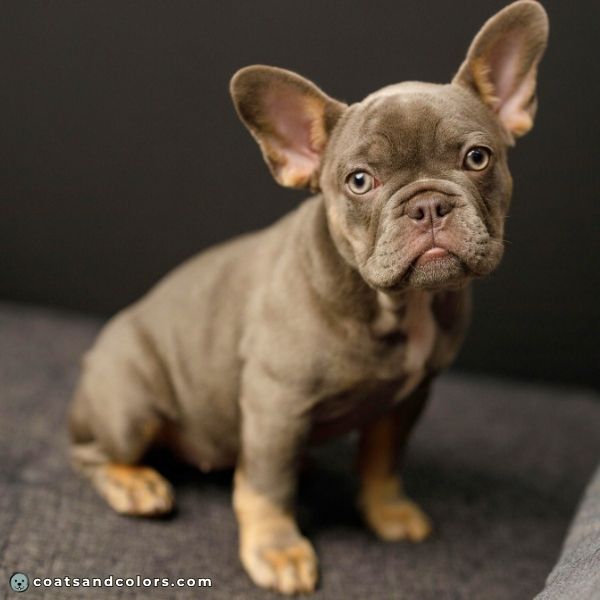
The cocoa mutation is only known in color-bred French Bulldogs. Frenchie people have their own terminology for variations of cocoa. Although it is an eumelanin color, we have ignored the cocoa color in this article, as it does not occur in many dogs and makes things unnecessarily complicated…
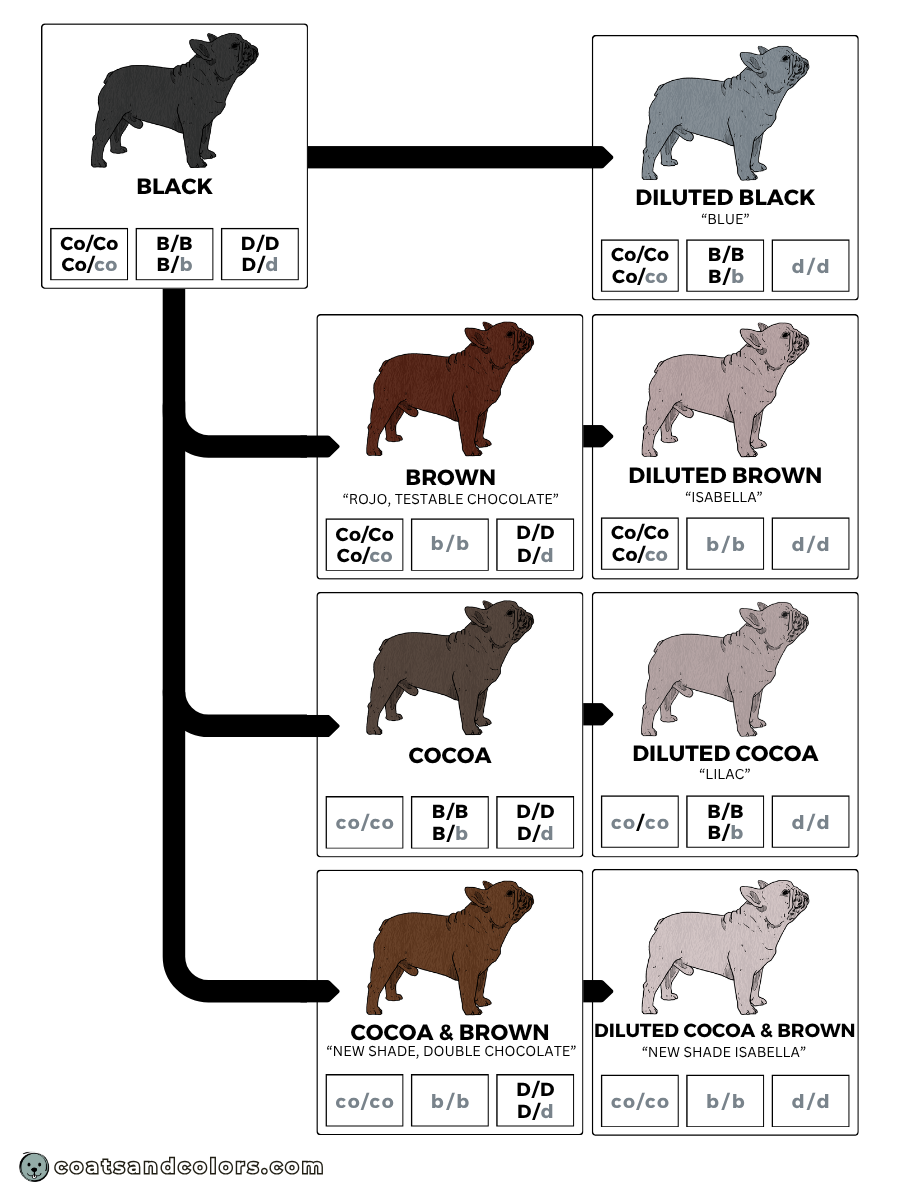
Base Color Modifiers
Some secondary traits like merle or graying can change how well the coat gets pigmented. And this can modify color intensity and produce lighter shades of the original base color.
We don’t count these traits as base colors of their own because they only affect some of the pigment. But these traits can not change the darkest possible color of eumelanin a dog can produce.
The nose or skin pigment will most often keep its original color. You always have to look for the darkest shade of eumelanin on a dog. A black nose indicates that a dog was born with black pigment.
Keep in mind, that these additional traits can all happen at the same time.
Merle
The four eumelanin base colors can produce one of four possible Merle base colors:
- Black Merle (“blue merle“)
- Slate Merle
- Brown Merle (“red merle“)
- Lilac Merle
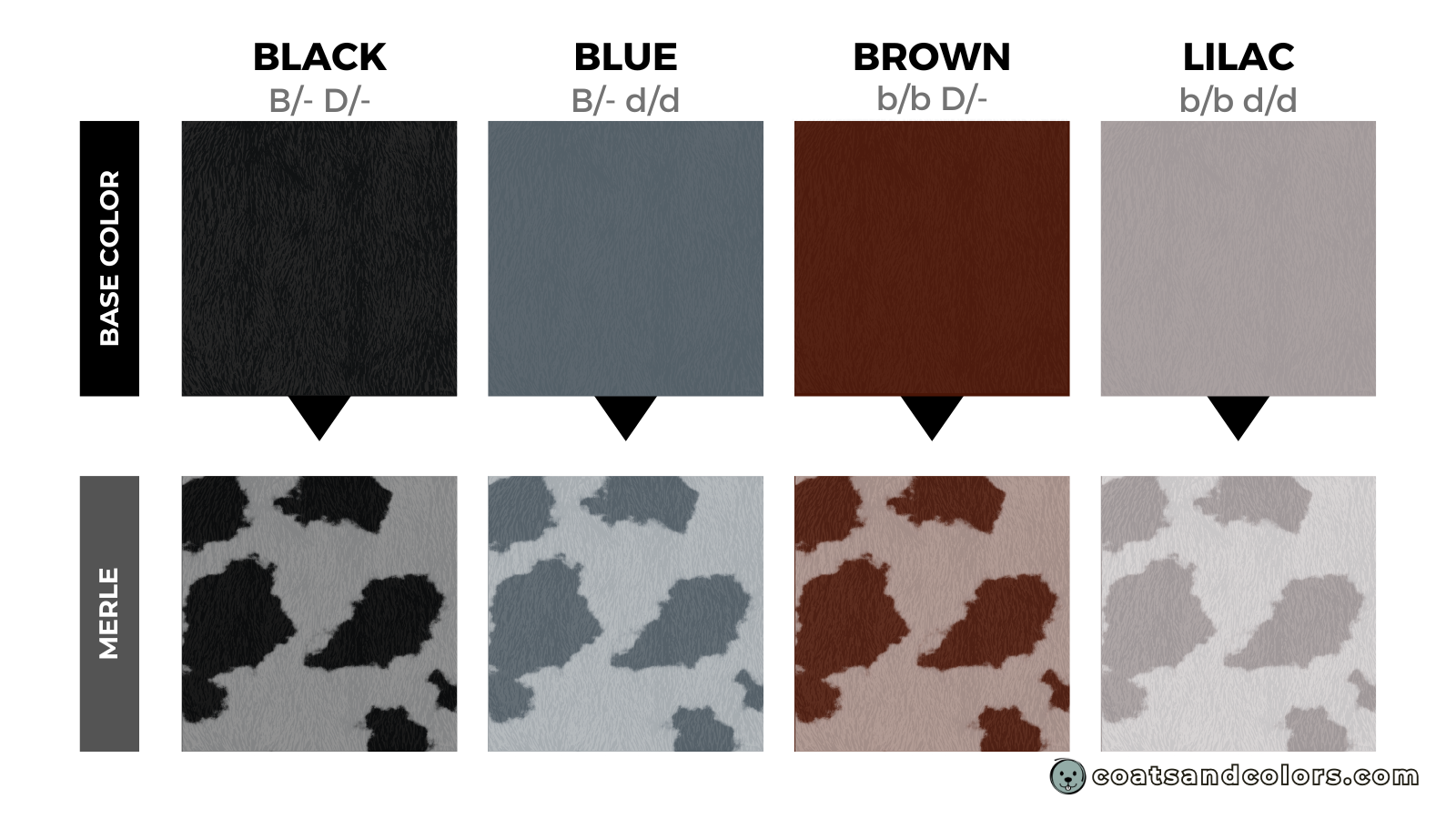
Merle will weaken some of the eumelanin in a dog’s pattern to lighter colors.
Some Merle dogs have dilute patches of different colors, sometimes even brownish. You will have to look at the darkest non-merled patches on a merle dog to determine a dog’s original base color.
Some dogs with a shortened Merle allele (Ma/m) express atypical Merle.
This is a muted version of merle with more evenly distributed pigment lightening and only few dots of the original color. This can mimic color dilution (as in, an atypical black merle may look solid blue).
Progressive Graying
The four eumelanin base colors can produce different faded base colors:
- Faded Black
- Faded Blue
- Faded Brown
- Faded Lilac
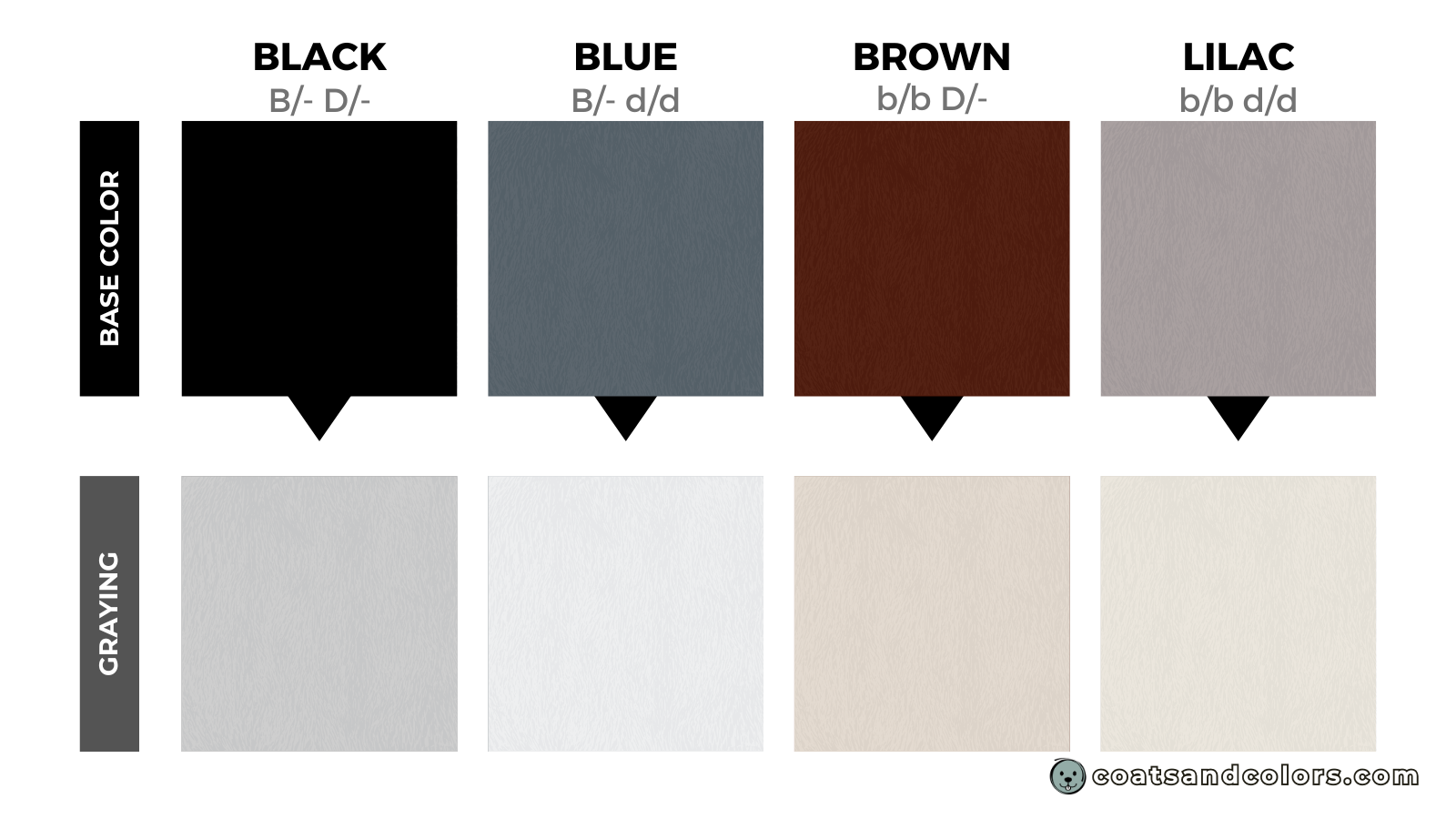
Progressive graying can cause a gradual fading of eumelanin color in some furnished dogs. Graying can turn black and blue to gray or silver or brown and lilac to pale beige or sandy colors.
Dogs are born with their original eumelanin base color before it starts to “gray out”.
Progressive graying only affects pigment in the hair.
Phaeomelanin is often less affected but the interaction between graying and intensity is still not fully understood. Many black & tan “phantom” Poodles also have very pale tan markings.
Seal
Ghost tan is caused by incomplete dominant black in KB/- dogs.
This enables some yellow pigment from the hidden A locus pattern to show through and produce a light undercoat. And this “ghost pattern” can cause silvery or reddish areas.
A ghost sable or a ghost agouti pattern is called “seal“. But dogs can also have ghost saddles or ghost tan points, it all depends on where in their hidden A locus pattern they have yellow pigment.
The four eumelanin base colors can produce one of four possible ghost sable variations:
Ghost tan can give a very reddish or brownish coat even in dogs with black pigment. This is especially pronounced in some seal merle phenotypes that sometimes produce weird red or orange undertones.

Summary
Each dog will express exactly one of all possible eumelanin base colors.
Its eumelanin can be either black, brown, blue, or lilac (or cocoa or diluted cocoa in Frenchies).
The eumelanin base color is expressed from birth and affects all the eumelanin on a dog.
A dog’s pattern determines if and where eumelanin will be visible in its coat. The eumelanin color can also be evaluated via the nose and skin pigment, even if there’s no eumelanin visible in the coat.
Additional traits such as progressive graying or merle can further affect how well eumelanin will be expressed in a pattern. This can modify a dog’s base color to lighter shades of the same color.
The most obvious example of pigmentation deficiencies are, of course, white markings. They can fully remove any pigment from the coat. But they will never affect pigment colors at all.
And some phenomena such as broken down pigment in older coat, rusting, sun-bleaching, or ghost tan can add reddish hues to eumelanic coat without changing a dog’s base color.
Learn More
Image Credits
© Victor G/unsplash.com
© Gurpreet Singh/unsplash.com
© Jane Thomson/unsplash.com
© Marian Florinel Condruz/pexels.com
© Rosa Gattuso/pexels.com
© Ryan Stone/unsplash.com
© Amal Santhosh/pexels.com
© Vika Yagupa/pexels.com
© Efrem Efre/pexels.com
© Vuk Wolf/pexels.com
© RosaJay/yayimages.com
© Juan Manuel Sanchez/unsplash.com
© Gabe/pexels.com
© Ivett Szabo/unsplash.com
© wooof woof/unsplash.com
© Julissa Helmuth/pexels.com
© Nikola Velickovic/unsplash.com
© Sharon Snider/pexels.com
© dpcrestock/yayimages.com
© cynoclub/yayimages.com
© slowmotiongli/canva.com
© Ben Hanson/unsplash.com
© Martin Vysoudil/unsplash.com
© Rebecca Johnsen/unsplash.com
© Michal Petráš/pexels.com
© Lucie Hošová/unsplash.com
© Jamie Street/unsplash.com
© SlimMars 13/pexels.com
© Michael G/unsplash.com
© ysbrand/depositphotos.com
© Zuzule/canva.com
© BP Miller/unsplash.com
© Laures/canva.com
© Seth Maughan/unsplash.com
© Sophie Hollies/unsplash.com
© igartist/canva.com
© eriklam/yayimages.com
© Firn/canva.com
© Robot Photo/unsplash.com
© Ian Talmacs/unsplash.com
© Duygu/pexels.com
© Ani Elisa Geigenmüller/pexels.com
© Avery Cocozziello/unsplash.com
© Lynnette Greenslade/unsplash.com
© rzoze19/canva.com
© Alexandre Daoust/unsplash.com
© Mirzat/unsplash.com
© Karola G/pexels.com
© Andrea Caramello/unsplash.com
© Ayumi Photo/pexels.com
© Leslie Beasley/pexels.com
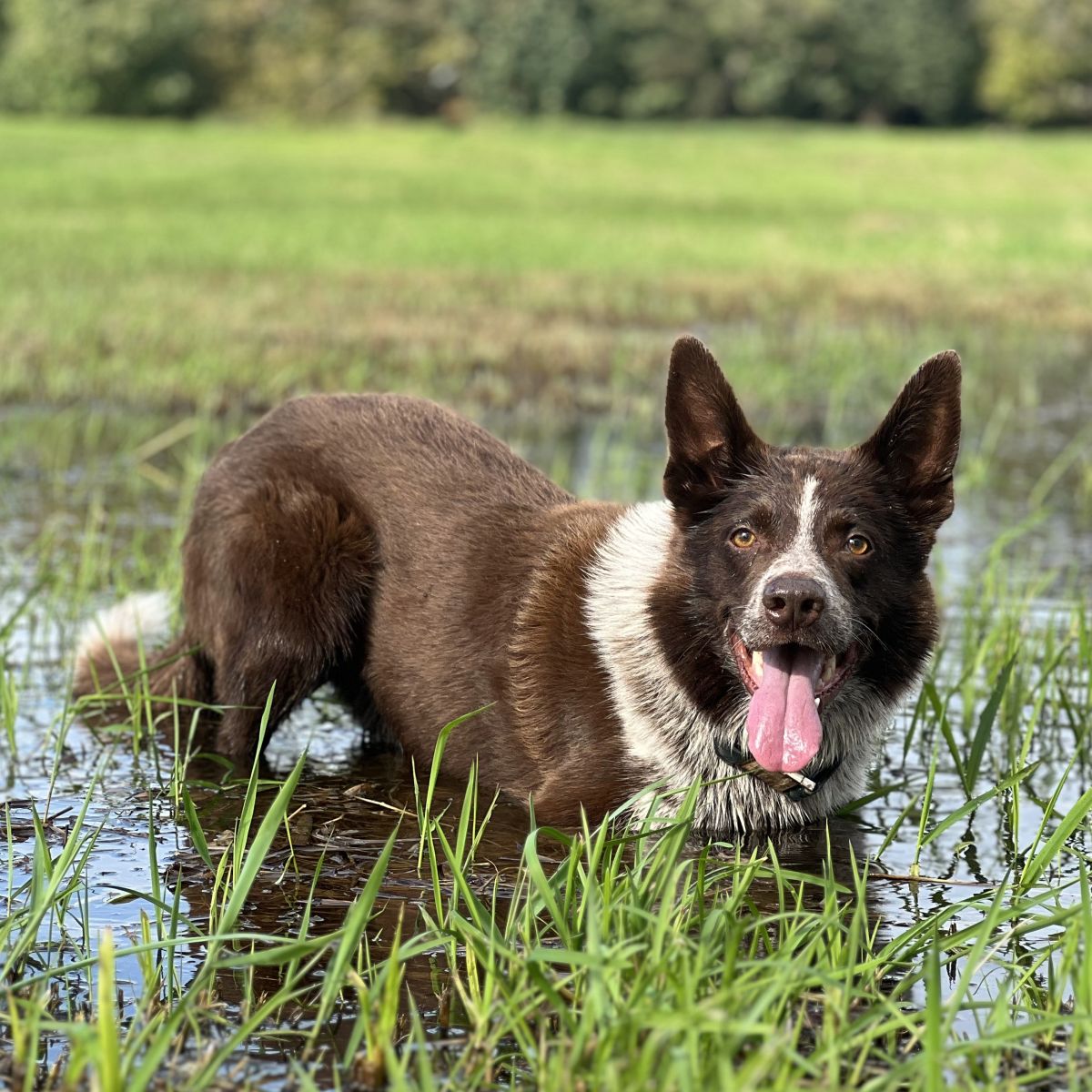
Hi! I’m Steffi. I am a biologist and a big time dog nerd. You are curious about coat color genetics? You’ve come to the right place! Read more.

